Sourdough Hoagie Rolls
Sourdough Hoagie Rolls! Hoagie, hero, sub, grinder, whatever you call your sandwich, this is a great roll for building your masterpiece.

Table of contents
Why these are is the best Sourdough Hoagie Rolls
Whatever you call it, there is no doubt that the key to a great sandwich is the perfect long roll.
The perfect sourdough hoagie roll should have a thin, crisp crust and a light, soft, slightly chewy crumb. This recipe makes the perfect sourdough hoagie roll.
By the way, if you don’t have a sourdough starter, you can make Hoagie Rolls with commercial yeast.
How to make Sourdough Hoagie Rolls
See the recipe card for detailed measurements and instructions.
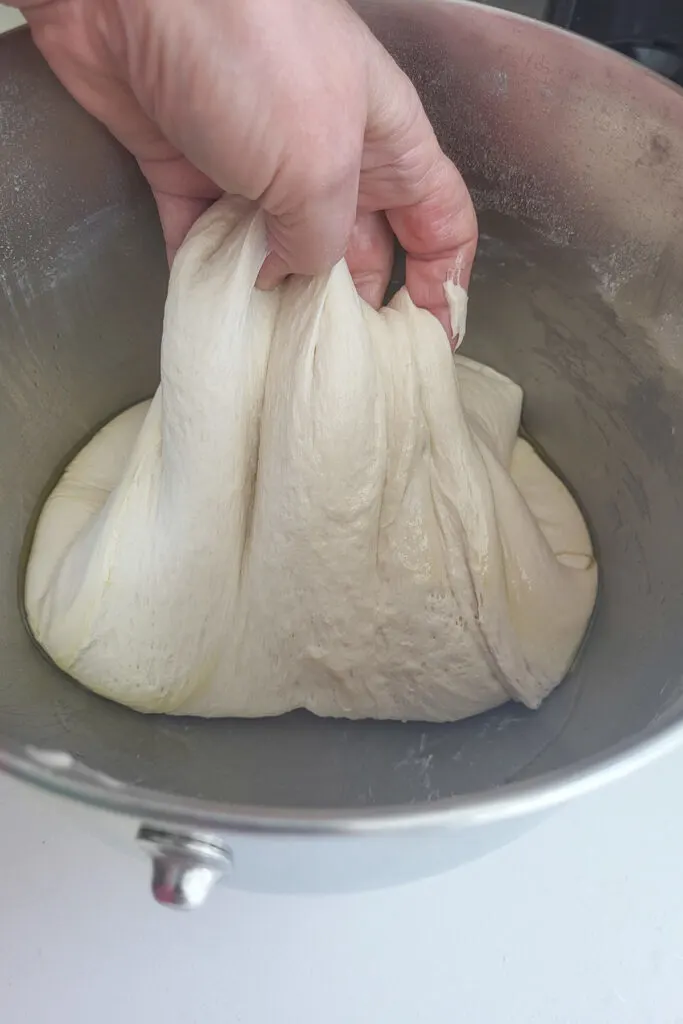
- After mixing the dough. Set it aside for 3-5 hours at room temperature.
- Every hour fold the dough to aerate and develop the dough.
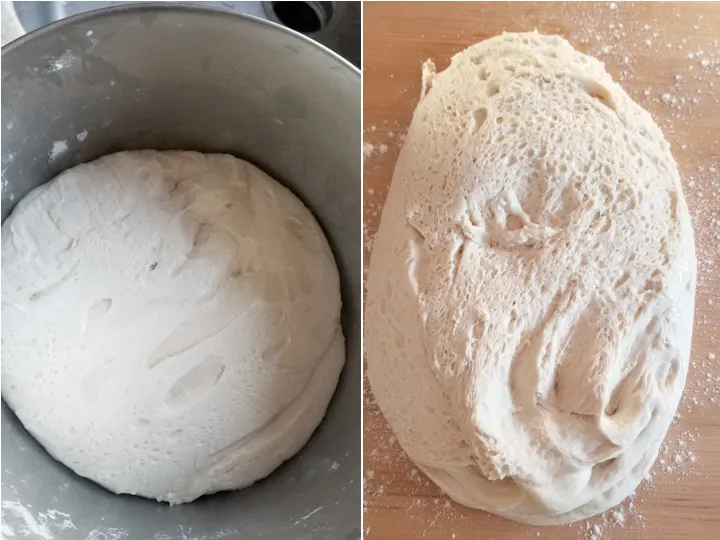
- After the initial fermentation at room temperature. Cover the bowl and refrigerate.
- Leave the dough to ferment overnight in the refrigerator.
- In the morning the dough should be well-aerated and ready for shaping.
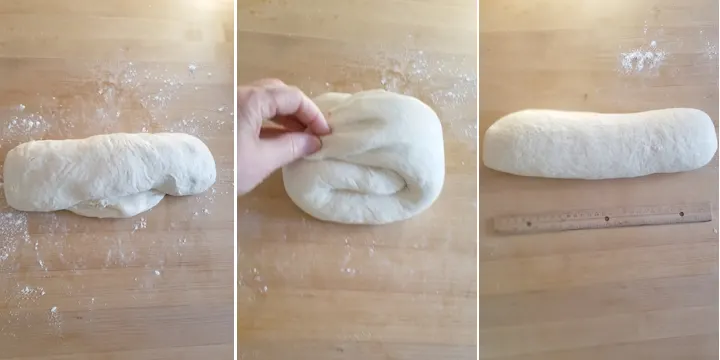
- Roll the dough to a 12″ log.
- Fold the two ends of the log towards the center.
- Roll the dough to a 12″ log again.
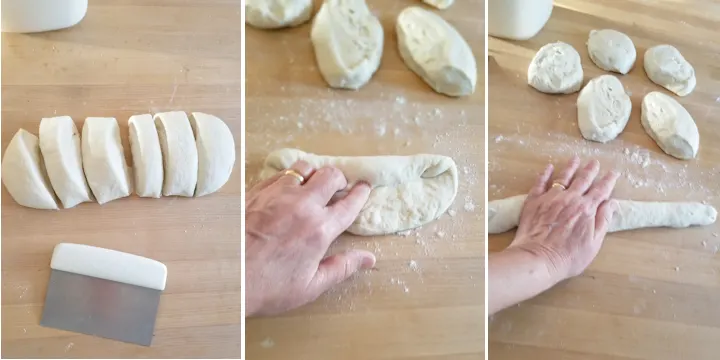
- Cut the dough into 6 pieces.
- Form each piece into an oval and roll the oval into a small log.
- Roll the dough to 10″ long.
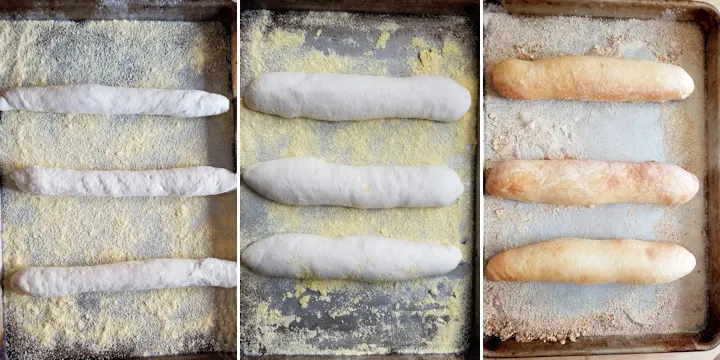
- Set the rolls onto a sheet pan to rise.
- Rise until doubled in size.
- Bake until golden brown.
A timeline for making Sourdough Hoagie Rolls:
- If your starter needs feeding, do that the night before or early in the morning of the day you want to make the dough.
- Mix the dough in the afternoon. Allow it to ferment at room temperature all day and refrigerate the dough in the evening before going to bed.
- The dough can stay in the refrigerator for 2-3 days at this point.
- Take the dough out first thing in the morning and shape the hoagie rolls.
- Leave them at room temperature to rise for 1 1/2- 2 hours.
- If you want to bake the same day, feed the starter the night before. Make the dough early in the morning and leave it to ferment until the afternoon. Form the rolls and leave them to rise, skipping the refrigeration step. Bake the hoagie rolls in time for dinner.
Storage
Sourdough Hoagie Rolls will keep at room temperature for 1-2 days but they’re best the day they are baked. Leftovers can be frozen for up to a month. Defrost and warm in a 200F oven to re-crisp the rolls.
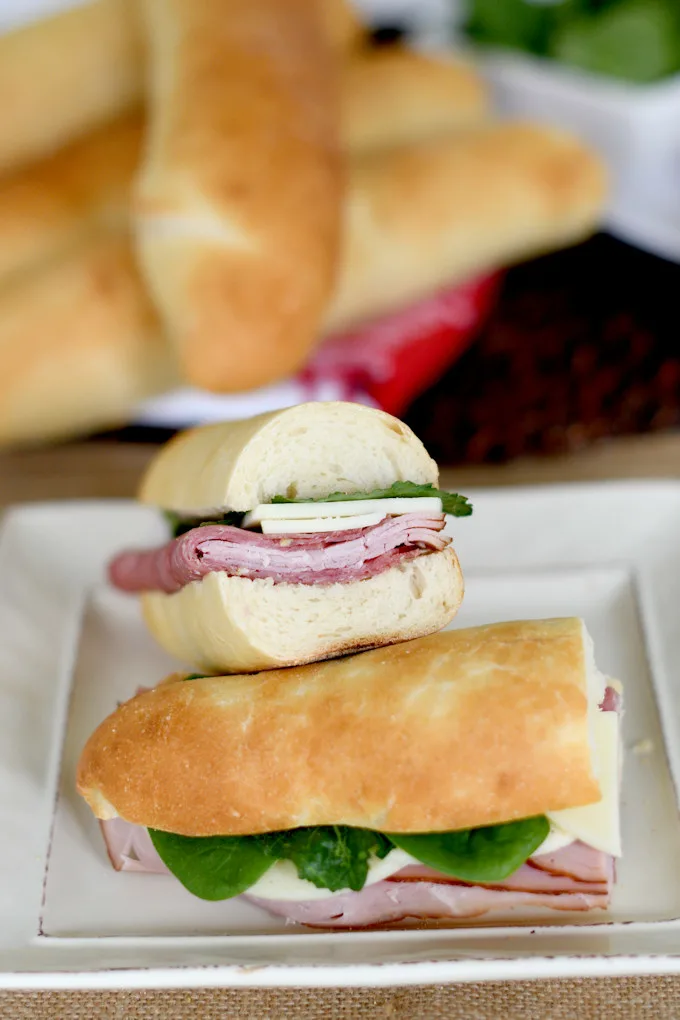
I know you love a good sandwich, so I highly recommend my Sourdough White Sandwich Bread and my Sourdough Whole Wheat Bread. Sourdough Rye Bread is also the base for a great sandwich.
Since you’ve got your starter fed, peruse the entire list of My Best Sourdough Recipes. Have fun!
I know you hate to throw away that sourdough discard. Check out these recipes that use sourdough discard.
If you love this recipe as much as I do, I’d really appreciate a 5-star review.
Sourdough Hoagie Rolls
Ingredients
- 8 oz Active Sourdough Starter (1 cup)
- 1 tablespoon granulated sugar
- 8 oz warm water (1 cup)
- 12 ½ oz unbleached all purpose flour (2 ½ cups, see note)
- 4 oz milk (½ cup, scalded and cooled to room temperature)
- 7 ½ oz unbleached bread flour (1 ½ cups)
- 2 teaspoons table salt
- cornmeal (for the sheet pans)
Instructions
- In a large mixing bowl or in the bowl of a stand mixer, combine 8 oz Active Sourdough Starter, 1 tablespoon granulated sugar and 8 oz warm water. Add 2 cups (10 oz) of the all purpose flour. Mix with the paddle on low speed until it forms a thick batter. Cover the bowl and set aside for 30 minutes.
- Add 4 oz milk, 7 ½ oz unbleached bread flour and 2 teaspoons table salt then mix to combine. If using a stand mixer, switch to the dough hook. With the mixer running, add the remaining all purpose flour. Knead the dough for 5 minutes until it is smooth and elastic. If mixing by hand add the flour using a wooden spoon and/or a plastic bowl scraper and knead by hand. Turn the dough out onto a floured surface and shape into a smooth ball.
- Transfer the dough to a lightly oiled bowl, turning once to coat the dough. Cover the bowl and set it aside at room temperature. After an hour, working from four corners of the dough (still in the bowl) use your hand to lift the top edge of the dough over into the middle of the dough. Repeat with the other 3 sides then flip the dough over. Every hour or so check on the progress of the dough by folding it over itself in the bowl. After about 3 hours the dough should be lively, elastic and airy. If the dough is still sluggish give it another hour or two at room temperature.
- Cover the bowl tightly, refrigerate overnight. At this point the dough can be held in the refrigerator for up to 2 days.
- In the morning, take the dough out of the refrigerator. Generously sprinkle 2 half sheet pans with corn meal.
- Turn the dough out onto a lightly floured surface. Without kneading, form the dough into a 12" log. Fold the two ends into the middle then roll back and forth to form a 12” log again. If at any point the dough springs back too much you can give it a 10 minutes rest then continue. Cut the log into 6 equal portions.
- On a lightly floured surface, pat a piece of dough into a 6” oval. Tightly roll the dough from the long side to form a 6" cylinder. Pinch the seam tightly. Using flat hands roll from the center out to form a 10” long roll. Let your hands go over each side to taper the ends of the roll. Set the roll onto one of the prepared pans. Continue forming the other rolls and place 3 on each pan.
- Cover the pans with a damp kitchen towel and set aside in a warm place to rise until doubled in volume (about 2-2 1/2 hours). The rising time will vary based on the temperature of the dough and the ambient temperature. Meanwhile, preheat the oven to 450 °F.
- To create steam in the oven, place a small pan onto the floor of the oven to preheat. If you have them, you can put lava rocks or whiskey rocks into the pan to preheat as well.
- When the rolls are ready to bake brush them lightly with milk. Place the trays in the oven. Pour a 1/4 cup of warm water into the preheated pan on the floor of the oven and immediately close the oven door.
- Bake until the rolls are golden brown, about 15-20 minutes. Turn the trays after 10 minutes to promote even browning. Cool completely on a wire rack before slicing.
Would you like to save this recipe?
As an Amazon Associate and member of other affiliate programs, I earn from qualifying purchases.








I don’t have bread flour and wanted to start these today. Will it completely change the rolls if I use all white flour?
The strong gluten from bread flour helps the rolls get a chewy texture. The rolls will work with all AP Flour, they just might have a softer texture. You may also need to sprinkle in a little more flour since higher protein bread flour absorbs more moisture than ap flour.
Can you explain step 3. Are these stretch and folds over 3 hours. Are we looking for the dough to rise any in those 3 hours or longer. It’s a bit confusing to me.
Yes, the dough should rise over those 3 or so hours. The exact time will depend on the condition of your starter, the temp of the dough and the room temp. The stretches and folds are to redistribute the yeast and to develop the gluten.
@Eileen Gray, so I am still confused. I have baked regular boules and usually bulk ferment happens after the stretch and folds. If the dough is on the counter for 3 plus hours and in that time I am performing stretch and folds, won’t it knock the air out?
Yes, it will knock some air out. But then the dough goes into the fridge for the night and will rise slowly. These are hoagie rolls. We’re not looking for big, uneven holes in the dough that you’ll often see in a rustic loaf. It’s a sandwich bread so it will have a smaller, more regular crumb.
how many grams is each roll if we are to scale them out before rolling? I put the formula into excel and have no idea what the original amount of dough was. How much to scale each roll? Thank you!
I weigh the dough before portioning and divide by 6. For example, if you had 1200g of dough each roll would be 200g.
Can this be done with all bread flour?
I use a combination of the two flours because you don’t want the hoagie rolls to be too chewy. If you only have bread flour you might want to hold back 1/4 cup because the high protein bread flour will absorb more water.
Wonderful recipe! My dough was happy after an overnight in the refrigerator. For anyone who felt the dough was too loose, don’t fear the dough – it shaped up beautifully in three hours in my 72 degree kitchen. Followed the recipe exactly with the exception of making smaller rolls. This one’s a keeper!